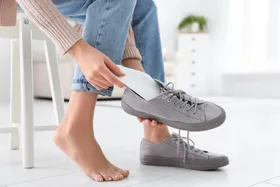What Is a Stone Bruise and What Can You Do About It?
Stone bruises cause sharp heel or ball-of-foot pain that can last weeks. Learn to recognize symptoms, when to see a doctor, and effective treatment options, including rest, ice, and supportive orthotics.
Updated October 16, 2025

Ever felt that sharp, throbbing pain in your foot after a misstep or a heavy object falling on it? Chances are, you've experienced a stone bruise, a common but often overlooked injury.
Stone bruises can be incredibly painful and debilitating. They can make walking, running, or even standing uncomfortable, significantly impacting your daily activities. And they can even take weeks to heal.
But don't worry; there's hope. In this guide, we'll dive deep into what stone bruises are, how to identify them, and most importantly, what you can do to treat them effectively and get back on your feet quickly.
» Find relief for stone bruises with our custom-made insoles
What Causes a Stone Bruise on Your Heel?
Stone bruises result from impact on the foot's ball or heel pad. They typically occur after stepping on a stone or running on uneven ground. When bones near the foot's end press together, it affects nearby nerves and causes pain and inflammation.
Pain may develop instantly or take up to 48 hours to appear. Besides stones and rough terrain, any activity involving repetitive foot impacts (like running or jumping) can cause these bruises. In fact, heel pain after running is fairly common.
Several factors increase the risk of stone bruises:
- Structural foot abnormalities (e.g., flat feet or high arches).
- Excess body weight.
- Loss of foot fat padding.
- Poor footwear.
- Foot conditions (e.g., bunions and rheumatoid arthritis).
» Learn all about burning heels
Symptoms Associated With Stone Bruises
Stone bruising often causes foot pain ranging from mild to severe, typically centering around the ball of the foot or footpad. You may experience:
- Tingling sensations.
- Shooting pain.
- Sharp pain.
- Burning sensations.
Other Conditions With Similar Symptoms
Be careful about assuming you have a stone bruise, as several other foot conditions share similar symptoms. These include:
- Metatarsalgia (inflammation of the ball of the foot).
- Heel spurs (bony growths on the heel).
- Stress fractures (small cracks in the bone).
- Morton's neuroma (nerve tissue thickening).
- Plantar fasciitis (inflammation of the tissue connecting the heel to the toes).
» Check out the difference between heel spurs and plantar fasciitis
How to Treat Stone Bruises on Your Heels
Stone bruises often heal on their own, but recovery can be slow. Apply ice for 10-15 minutes at a time to relieve pain and reduce swelling. Over-the-counter pain relievers or anti-inflammatory drugs like ibuprofen may also help manage pain and inflammation. While healing, avoid walking barefoot and consider losing weight if necessary to reduce pressure.
If you think you have a stone bruise but it doesn't improve with rest and home care within a week, see a podiatrist or doctor. Take proactive action if you notice signs of inflammation, such as redness, soreness, or swelling, or if pain worsens rather than improves.
To speed up healing, try several methods. Orthotics, such as running inserts, can provide extra arch support and reduce pain.
Upstep's On My Feet All Day insoles provide relief from stone bruise pain. They offer arch support to distribute your weight evenly, reducing stress on your metatarsal bones. Plus, their extra cushioning absorbs shock, relieving pressure on your sore heels.
We make our insoles custom, which means they cater specifically to your foot shape. This personalized fit ensures optimal comfort and support, which is essential in managing and preventing further injury related to stone bruises.
Don't Let Stone Bruises Slow You Down
A stone bruise can be painful, but with the right care, you can heal quickly. Early diagnosis and treatment are important.
Home remedies can often help relieve pain and speed up healing. But if symptoms persist, see a doctor. They will examine you and may order tests to rule out other conditions and recommend the best treatment.
» Shop our collection of custom-made insoles and relieve stone bruise pain
FAQs
How long does a stone bruise take to heal?
A stone bruise, depending on its severity, typically takes 2-6 weeks to heal. Rest, ice, and support are key to faster recovery.
Will Epsom salt help with stone bruises?
Epsom salt soaks may provide temporary comfort by promoting relaxation, though there's limited scientific evidence for its effectiveness specifically for stone bruises. If you choose to try it, soak your foot in warm (not hot) water with Epsom salt for 15-20 minutes. However, focus on proven treatments like rest, ice, proper footwear, and see a doctor if pain persists.
Can a stone bruise turn into abscess?
Yes, a stone bruise can turn into an abscess if it becomes infected. Signs of infection include increasing pain, redness, swelling, and warmth around the bruise. If you notice these symptoms, consult a doctor.
How can I tell a difference between a stone bruise and plantar fasciitis?
Stone bruises typically cause a sharp pain at the bottom of your foot, often near the heel. They're usually caused by a specific injury. Plantar fasciitis causes a dull, aching pain in the heel, especially in the morning. It's often due to overuse or inflammation of the plantar fascia, a tissue connecting your heel to your toes. If you're unsure, consult a doctor.
What does a stone bruise look like?
A stone bruise often appears as a small, bluish, or purplish discoloration on the bottom of your foot. It might be tender to the touch and can cause pain when walking or standing. But it's important to note that not all stone bruises have visible bruising.
Disclaimer: The information on this blog is for educational purposes only and is not a substitute for professional medical advice. Upstep does not provide medical diagnosis or treatment. While qualified healthcare professionals create our content, it's essential to consult with your healthcare provider for any foot or ankle concerns you may have.








